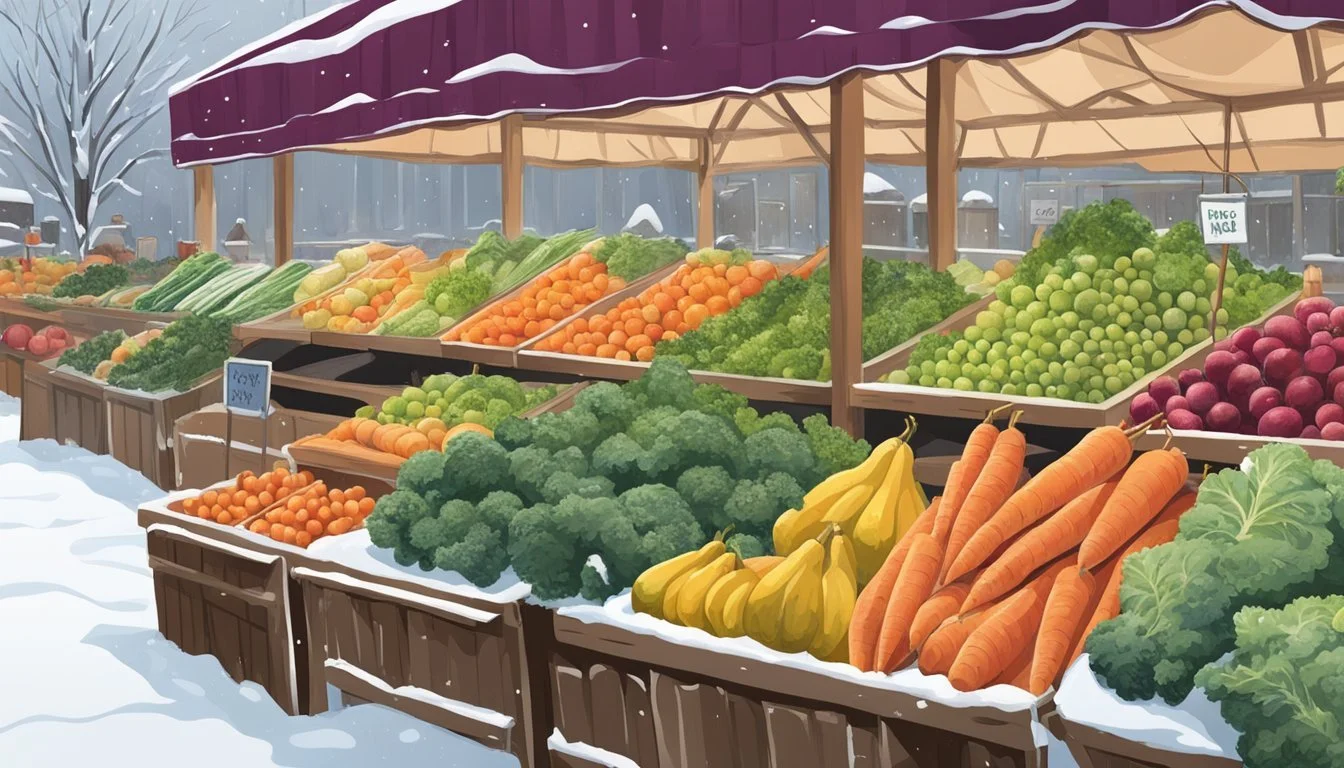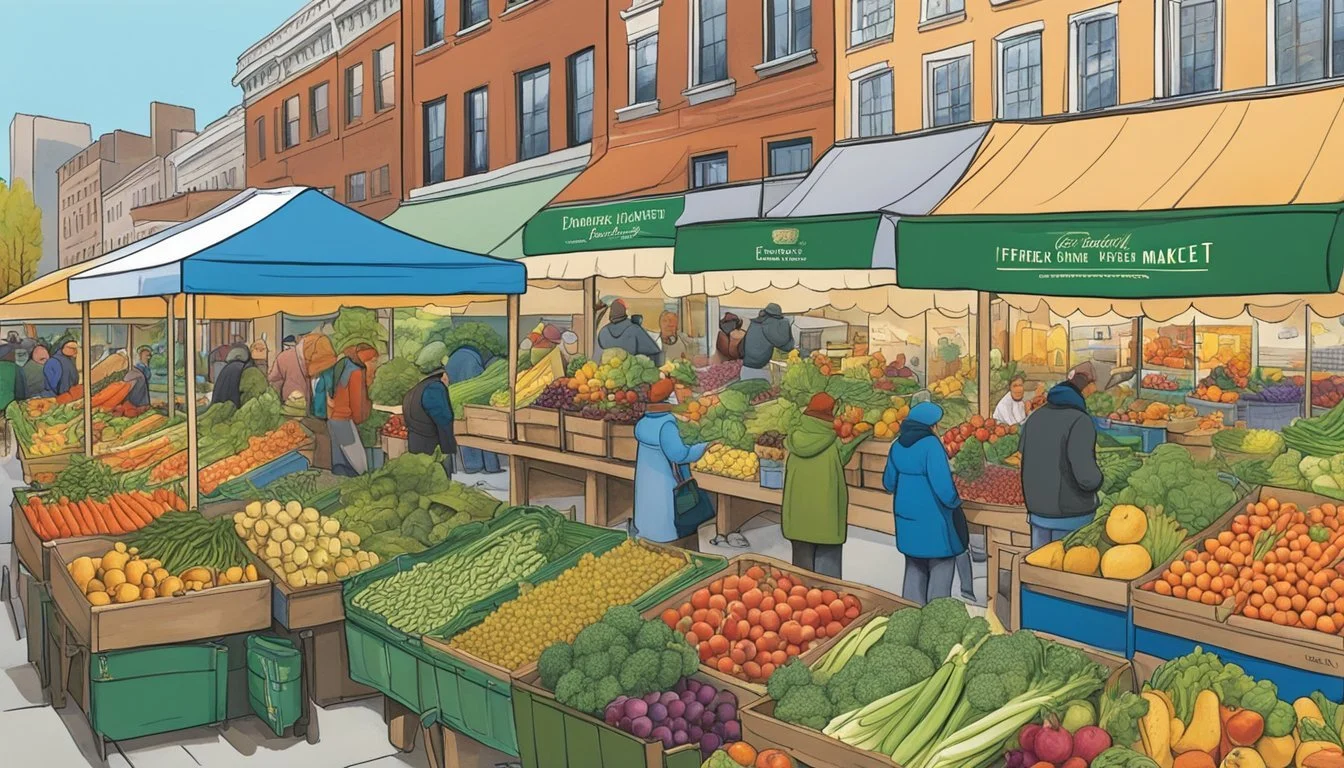New York Seasonal Fruit & Vegetables in February
Your Fresh Guide
This Article is Part of our New York Seasonal Fruit & Veg Calendar
In the heart of winter, New York's produce selection adapts to the cold February climate. Despite the chilly temperatures, a range of fruits and vegetables remain available, offering a fresh taste of local bounty. February in New York presents a unique opportunity to support local farmers and enjoy seasonal produce that is harvested within the region.
Seasonal eating in February centers around robust root vegetables and hearty greens that can withstand the colder weather. Markets throughout the state showcase these resilient varieties, catering to consumers who prioritize local and seasonal eating. These locally sourced items not only help reduce the carbon footprint associated with long-distance transportation but also provide peak nutrition and flavor.
Availability of specific fruits and vegetables can vary based on weather patterns and regional differences within New York. Nonetheless, consumers can typically find a selection of stored produce like apples alongside cold-tolerant greens, emphasizing the versatility and richness of February’s seasonal offerings. As such, eating seasonally this month means enjoying produce that has been naturally suited to the environment, ensuring both freshness and sustainability.
Understanding Seasonality in New York
In New York, seasonality greatly influences the variety and availability of local produce, highlighting the importance of understanding regional crop calendars and supporting local farming practices.
Seasonal Calendar Overview
New York's produce calendar defines what is grown and harvested throughout the year. Each season comes with a different set of crops that are ripe for picking. February, often characterized by cold temperatures, offers a limited but valuable selection of produce.
Produce available in February may include:
Root vegetables: carrots, potatoes, and beets
Leafy greens: kale (What wine goes well with kale?) and collard greens (how long do collard greens last?)
Storage crops: apples, onions, and cabbages
The Importance of Eating Local Produce
Eating local produce supports New York's economy and minimizes the environmental impact of transportation. It also ensures freshness, as fruits and vegetables are consumed closer to their harvest date.
Factors Affecting Crop Availability
Multiple factors influence New York's crop availability: soil type, altitude, and microclimates. Urban farming initiatives have also started to shape the produce landscape, offering locally-grown options beyond traditional field crops.
February's Seasonal Weather Impact
Weather plays a significant role in determining crop success. In February, New York's cold and snow can hinder growth, shortening the list of available local produce. Farmers depend on protective measures like greenhouses to extend the growing season.
Local Farming Practices
Farmers in New York might utilize techniques such as crop rotation and cover cropping to manage soil health and pest control. These sustainable practices contribute to the year-round availability of some crops and ensure the vitality of farms for future harvests.
Seasonal Fruits in February
February in New York offers a select variety of fresh fruits that are both nutritious and vibrant. The market thrives with winter-harvested citrus and tree fruits, complemented by a range of exotic varieties sourced from warmer climates.
Citrus Fruits
In February, citrus fruits are at their peak. Oranges and lemons provide a refreshing zest and are abundant during this month. Consumers can find these fruits with a distinctly fresh and tangy flavor, ideal for adding a burst of vibrancy to winter meals.
Oranges: Navel, Blood oranges
Lemons: Eureka, Meyer
Tree Fruits
The tree fruit selection is limited during the cold New York winters, but apples remain a staple. With storage technologies, various apple varieties retain their crisp texture and rich flavors well into the winter season.
Apples: Red Delicious, Granny Smith
Berries Availability
Although not peak season for local varieties, strawberries and other berries are typically available from import sources. These berries are often less flavorful compared to their in-season counterparts but provide an option for those seeking berry fruits.
Strawberries: Imported, available in limited quantities
Exotic and Imported Varieties
February also sees a range of exotic and imported fruits to compensate for the local off-season. These fruits include tropical varieties which are transported from warmer regions and offer a taste of summer during the colder months.
Kiwi: Sourced from Italy or Chile
Pineapples: Sourced from tropical regions
Nutritional Benefits of Seasonal Fruits
The seasonal fruits available in New York during February are rich in vitamins and antioxidants. For instance, citrus fruits, such as oranges and lemons, are high in vitamin C, which can boost the immune system during the chill of winter. Apples, with their dietary fiber, contribute to a healthy digestive system. Consuming these fruits fresh ensures the highest level of nutrients and taste.
Seasonal Vegetables in February
In New York during February, a variety of vegetables are in season, offering a range of flavors and nutritional benefits. The cold month doesn't hinder the availability of certain root vegetables, leafy greens, cruciferous vegetables, alliums, and squashes.
Root Vegetables
Root vegetables thrive in the cooler temperatures of New York's winters. February's selection includes:
Potatoes: Starchy and versatile, they are excellent for a variety of dishes.
Beets: Sweet and earthy, suitable for salads and roasting.
Carrots: Crunchy and nutritious, often used in both raw and cooked forms.
Turnips: Pungent and slightly bitter, a good addition to stews and soups.
Radishes: Crisp and peppery, perfect for adding a bite to salads.
Parsnips: Sweet when cooked, they make a great puree or roasted side dish.
Celery Root (Celeriac): With a flavor reminiscent of celery, used mashed or in soups.
Rutabagas: A cross between cabbage and turnips, ideal for mashing or roasting.
Leafy Greens
Even in the cold season, leafy greens are available and packed with nutrients. Greens to look for in February are:
Kale: A hearty green that can withstand cold, good for chips or salads.
Lettuce: Various types, each offering a different texture and flavor to salads.
Spinach: Tender and versatile, used in salads, soups, and sides.
Collards: Robust flavor, often cooked slowly to enhance their taste.
Swiss Chard: Colorful and mild, suitable for sautés and salads.
Arugula: Peppery, adds a zing to salads and pizzas.
Cruciferous Vegetables
These vegetables are known for their health benefits and are in season in February:
Cabbage: Ranges from sweet to sharp in flavor, used in slaws and ferments.
Broccoli: Provides a crunchy texture; steamed, stir-fried, or roasted.
Brussels Sprouts (how long do brussels sprouts last?): They offer a nutty flavor when roasted or pan-fried.
Cauliflower: Mild and adaptable, turning sweet when roasted.
Alliums
Alliums are foundational for flavor in many dishes, and these are available in February:
Onions: A base for soups, stews, and sautés.
Scallions: Mild and versatile, used both raw and cooked.
Garlic: Intense and aromatic, indispensable in savory recipes.
Leeks: Mild and sweet, excellent in pies and soups.
Squashes and Gourds
Though commonly associated with autumn, some squashes are available in winter:
Winter Squash: Dense and sweet, perfect for soups and purées.
Zucchini: Although not typical in February, sometimes greenhouse-grown specimens are available.
Health Benefits of Seasonal Vegetables
Eating vegetables that are in season in February provides the following benefits:
Nutrients: Vegetables like kale and spinach offer vitamins A and C, while root vegetables like carrots provide beta-carotene.
Fiber: Crucial for digestive health, found in high quantities in root vegetables and leafy greens.
Antioxidants: Cruciferous vegetables like broccoli and Brussels sprouts contain compounds that may support cellular health.
Consuming seasonal vegetables not only supports local agriculture but also ensures the freshest produce, packed with optimal flavor and nutritional value.
Harvest and Availability
In February, New York's seasonal selection is limited due to its cold climate, but storage crops and greenhouse produce maintain a presence in the market.
Harvest Timing for Fruits and Vegetables
Fruits: Apples and pears are typically harvested in late summer and fall but are available from cold storage. Vegetables: While new harvests are scarce, vegetables such as carrots and onions from the previous season remain available through effective storage techniques.
Peak Availability Times
Apples: Storage ensures a consistent supply throughout February. Root Vegetables: Carrots and potatoes have a stable availability due to their storability.
Locating Fresh Produce
In February, consumers can find New York's seasonal produce at local farmers markets and some grocery stores. Availability might vary based on the region within the state and market conditions.
Farmers Markets: A central place where stored apples, carrots, and other durable vegetables can be found.
Grocery Stores: Larger stores may source both in-state and out-of-state produce to meet demand for fresh fruits and vegetables during this time.
Preparation and Storage Tips
Maximizing the freshness and flavor of New York’s seasonal fruits and vegetables begins with understanding proper storage and preparation techniques. Below are key strategies for handling February’s local produce to enhance their shelf life and reduce food waste.
Proper Storage Techniques
For fruits, such as apples that are stored well in cool temperatures, they should be kept in a crisper drawer away from vegetables to prevent ethylene gas from accelerating spoilage. Vegetables like collard greens benefit from being wrapped in a damp paper towel and placed in a plastic bag prior to refrigeration to maintain their moisture and firmness.
Apples: Crisper drawer, away from vegetables.
Collard Greens: Damp paper towel, plastic bag, refrigerate.
Preparing Seasonal Produce
When preparing vegetables such as collard greens, washing and cutting them only just before cooking can preserve their nutrients and freshness. Avoid soaking as it can lead to nutrient loss.
Preservation Methods
Freezing is an excellent method to preserve fruits and vegetables, though blanching vegetables before freezing is crucial to retain color and texture. For long-term storage, canning and drying are effective, though following safe preservation practices is essential to prevent food spoilage.
Freezing: Blanch vegetables, then freeze.
Canning/Drying: Follow safe preservation practices.
Extending Shelf Life
One can extend the shelf life by keeping fruits and vegetables in their optimal conditions. For instance, storing root crops like turnips in a cool, dark place can significantly extend their freshness. Regularly checking stored produce and removing any spoiled pieces will help the rest stay fresh longer.
Root Crops: Store in cool, dark place.
Regular Checks: Remove spoiled pieces promptly.
Avoiding Food Waste
Consume highly perishable fruits and vegetables like leafy greens early in the week to minimize waste. For slightly overripe fruits, consider incorporating them into baking or smoothies instead of discarding them.
Leafy Greens: Eat early in the week.
Overripe Fruits: Use in baking or smoothies.
Supporting Local Agriculture
Supporting agriculture within New York directly impacts the robustness of the local food system, particularly in the availability of seasonal produce. By choosing to support local farms, consumers not only obtain fresh produce but also contribute to the economic vitality and sustainability of their communities.
Benefits of Supporting Local Farms
Local farms in New York provide a plethora of benefits to both the economy and the environment. Economically, local purchases bolster farm revenues, enabling farmers to maintain operations and support their families. Environmentally, local farms often employ sustainable practices that reduce the carbon footprint associated with long-distance transportation of goods. Specifically, local farms in New York are critical in supplying fresh, seasonal produce like root vegetables and winter squash during February.
Here is a list of specific benefits when supporting New York's local farms:
Economic Support: Money spent locally circulates within the community, often referred to as the multiplier effect.
Freshness: Local produce is harvested at peak ripeness, ensuring maximum nutrient content and flavor.
Sustainability: Reduced transportation distances can lower greenhouse gas emissions.
Community Supported Agriculture (CSA) Programs
CSA programs are a significant pathway for consumers in New York to engage with local farms. These programs allow individuals to purchase "shares" of a farm's harvest in advance. In return, they receive a regular distribution of fresh produce throughout the farming season. Beyond the fresh, seasonal produce, CSA members often gain a direct connection to the food they eat and the land where it grows.
Table Summary of CSA Program Benefits:
Benefit Description Connection Members connect with the farm and understanding of how their food is produced. Freshness Produce is received directly after harvest, ensuring peak flavor and nutrition. Variety Exposure to a wide range of produce, including some lesser-known varieties.
Farmers’ Markets and Direct Purchases
Farmers’ markets and direct purchases are critical components of supporting local agriculture in New York. Farmers’ markets serve as a hub where consumers can buy a diverse array of seasonal, locally-grown produce straight from the cultivators. Direct purchases may involve buying from farm stands or through online platforms which connect consumers with local producers.
Points to consider for New York's farmers’ markets and direct purchase opportunities:
Accessibility: Farmers’ markets are widely accessible across New York, offering seasonal fruits and vegetables.
Transparency: Provides a transparent food system where consumers can inquire about growing practices and product origins.
Community Engagement: Markets serve as community gathering spaces, strengthening the bond between local residents and farmers.
By frequenting farmers’ markets and participating in CSA programs, New Yorkers play an active role in sustaining local agriculture, fostering a community-oriented food culture, and ensuring the continuity of fresh, seasonal produce throughout the year.
Cooking with Seasonal Produce
In February, New Yorkers have the opportunity to explore a variety of winter fruits and vegetables to create flavorful and healthy meals. By focusing on locally available produce such as citrus fruits, root vegetables, and leafy greens, one can enrich their diet while supporting local agriculture.
Recipe Ideas for February
Citrus fruits: Use oranges, lemons, and grapefruits to add zest to salads, marinades, and desserts.
Root vegetables: Turnips and sweet potatoes can be roasted or mashed for hearty side dishes.
Leafy greens: Kale and spinach are perfect for warm salads, soups, and stews.
Seasonal Diet and Health
Boosted immunity: Winter citrus fruits are rich in vitamin C, contributing to immune system health.
Dietary fiber: Vegetables like cauliflower and carrots provide essential fiber, aiding digestion.
Incorporating Winter Produce Into Meals
Breakfast: Add sautéed spinach to omelets or fold kale into smoothies.
Lunch and dinner: Create stews with carrots and sweet potatoes or bake a cauliflower gratin.
Pairing Local Produce with Proteins and Grains
Seafood: Grapefruit or orange segments bring brightness to grilled fish.
Poultry and meat: Serve roasted chicken or pork with a side of roasted root vegetables.
Grains: Toss cooked grains like farro (how long does farro last?) or barley (how long does barley last?) with a lemony kale salad.
Conclusion
In February, New York offers a limited yet nutritious selection of seasonal produce. Consumers have the opportunity to support local farms by purchasing available fruits and vegetables which contribute to healthy eating habits.
Local farms harvest winter-hardy produce such as:
Kale: A leafy green, rich in vitamins A, K, and C.
Collard Greens: Another nutrient-packed leafy vegetable.
Even in the colder month of February, New Yorkers can enjoy these fresh, locally grown ingredients that are typically hearty enough to withstand the chilly temperatures.
Local farmstands and farmers' markets remain active with winter offerings, ensuring that patrons can continue to enjoy local, seasonal food. The reliance on these resources supports the region's agricultural economy and promotes sustainability.
As the month is synonymous with colder weather and a sparser harvest, it underscores the ingenuity of New York farms to provide fresh food year-round. Those looking to embrace seasonal eating can still do so in February with the expectation of wholesome and hearty produce selections.







